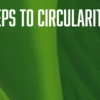By Teju Adisa-Farrar, Founder and Ecosystems Director at Black Fiber & Textile Network
For over a decade, terms like circularity, sustainability, regenerative practices and eco-consciousness have often been used without clear and consistent definitions. In the apparel and textile sector, it’s essential to clarify what these terms mean in order to foster a common understanding and promote thoughtful accountability.
Starting with circularity, it’s important to define what this concept means at a basic level. Circularity is: something that ends and begins in the same place. True circularity is possible when an ecosystem approach is taken because ecosystems cycle through the environments in which they exist. Achieving true circularity, however, requires a transformation of the entire ecological and economic system.
One major obstacle to achieving circularity and regenerative practices in the apparel and textile industry is the sector’s allegiance to the concepts of “scale” and profit maximisation. This focus on scaling up and increasing profits is a key driver of the climate crisis, as it often blocks the adoption of truly sustainable solutions. In contrast, regenerative solutions are place-based, bioregional, and community-centred. While these approaches may not maximise corporate profits, they do promote meaningful economic development and support local communities and ecosystems.
Embracing an ecosystem approach to circularity would position the apparel and textile sector to contribute significantly to the sustainable future we so urgently need. Although transforming supply networks and business mindsets is challenging, expanding these paradigms is essential to assuming a leading role in the emerging regenerative economy.
To take an ‘ecosystem approach’, we must first define what an ecosystem is. An ecosystem is a geographical area where living organisms – such as plants, animals, landscapes, topographies, people and microorganisms – interact to form an intermutually dependent environmental system. Each element in an ecosystem is interconnected, either directly or indirectly.
In relation to the textile industry, an ecosystem approach recognises that each stage in the production process needs to be nurtured and aligned, creating a foundation where all parts can thrive and adapt collectively to challenges and technological shifts.
In the apparel and textile industry, circularity cannot simply be ‘added’ to a supply chain. Indeed, we should not continue to think in terms of supply ‘chains’ at all. Today’s supply chains are based on linear models of sourcing and material flows. In my work, we prefer the term ‘supply networks’ or supply webs. A supply chain is fragile; if one link breaks, the whole system is disrupted, as we saw at the start of the COVID-19 pandemic.
In contrast, supply networks and webs are more resilient because they inherently allow for gaps to occur without the entire system collapsing. Supply networks are decentralised, responsive to geographical nuances and don’t rely on uniformity. This desire for uniformity in traditional supply chains drives linear and centralised models. To move towards a sustainable, regenerative future, the textile and apparel sector must embrace flexibility over uniformity.
Regenerative frameworks can be used as a pathway to circularity. For example, the core tenet of regenerative agriculture is that it starts and ends in the same place: the soil. Fibre and textile production illustrates how regenerative agricultural systems can lead to circular economies. Regenerative agriculture offers strategies for building circular economies that prioritise cultural, environmental and economic equity. The chart below provides an overview of how regenerative strategies can be applied to circularity efforts in ways both large and small.
REGENERATIVE ECOSYSTEM STRATEGIES | CIRCULAR ECONOMY OPPORTUNITIES |
| Use as much of the raw material as possible // think about production and decomposition. | Retaining more value from materials we use by reducing (or eliminating) waste, and creating cycles of uses. |
| Work with decentralised ecological networks (e.g. mycelium and other organisms). | Preferring supply networks rather than supply chains to create resilience and honour nuance. |
| Learn from Indigenous practices of relationship to and reciprocity with our environment. | Focus on cultivating and maintaining equitable (continuous) relationships rather than incentivising profit. |
Working towards true circularity in the apparel and textile sector requires us to reimagine the way we approach production, distribution, labour and consumption. A shift from linear supply chains to resilient supply networks, undergirded by an emphasis on regenerative frameworks, offers a pathway to create sustainable, equitable systems. True circularity requires an ecosystem approach—one that recognises the interconnectedness of all elements in the production cycle. An approach that promotes adaptability and collaboration across communities and geographies. By defining a shared language to discuss this, and by centring regenerative strategies, the industry can move beyond profit-driven scaling and towards meaningful economic development that supports both local ecosystems and global sustainability. Achieving this transformation will be no small feat, but it’s essential for aligning this industry with a regenerative future.

















